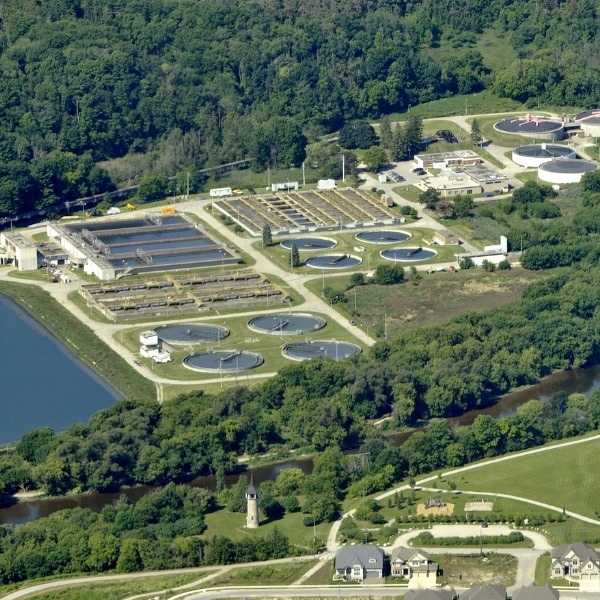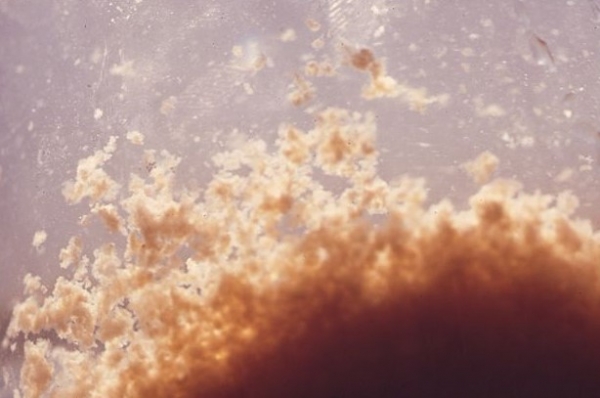Water Treatment

Water treatment plant near Kitchener, Ontario (SkyF, iStockphoto)

Water treatment plant near Kitchener, Ontario (SkyF, iStockphoto)
How does this align with my curriculum?
Learn about how water is treated at municipal water treatment plants.
Municipal Water Treatment
We use water every day for drinking, showering, flushing toilets, and washing clothes. We are so used to on-demand, clean water that we often don’t stop to think - where is this water coming from? We take our drinking water from lakes, rivers, and reservoirs. Sometimes, water is also taken from underground. We call this water groundwater. No matter where it comes from, we have to clean water before we can use it. This is called water treatment. Water treatment involves several steps that make water safe to drink.

- Pre-treatment is the first step in water treatment. In this step, water passes through a screen which keeps large debris such as sticks or trash from moving on. This is especially important when the water comes from lakes or rivers. These types of water tend to have more large pieces of debris than groundwater.
- Next, water goes through flocculation. This is a process that removes smaller debris, silt, and microorganisms from water. We add chemicals to the water that make the dirt and particles stick together. These particles form clumps or flocs. Many of these large clumps sink to the bottom of the water. We call this sedimentation. The solids are then removed from the water.
- The next step in the process is filtration. Water flows through filters made of sand and coal. This filters out any remaining solid particles.
- The final step of the water treatment process is disinfection. In this step, chlorine is added to the water. This kills any microorganisms that may cause diseases. Water is then piped into homes, schools, and businesses for people to use. This step is known as distribution.
Wastewater Treatment
Water that we flush down the toilet or send down the drain is called wastewater. Wastewater needs to be cleaned before it can be safely returned to the environment or reused. There are three main stages of wastewater treatment. These stages take place at a water treatment plant.
Did you know?
Wastewater spends from 8 to 16 hours in a treatment plant before it can be returned to the environment.
Wastewater passes through a screen as it enters a treatment plant. This screen removes large debris such as trash. Wastewater then enters the primary treatment stage. In this stage, solid waste is removed. Wastewater sits in large tanks, allowing solids to sink to the bottom. The sludge which settles at the bottom of the tank is then pumped away.
The sludge is then left behind and wastewater moves on to the secondary treatment stage. In this stage, a process called aeration removes smaller pieces of organic matter. Air is pumped into tanks of water. Bacteria use this extra air to break down organic matter more quickly. This organic matter then settles and is removed. Any remaining grit, grease, and oils are also removed. After secondary treatment, water is 90 to 95% free of pollutants.
Tertiary treatment is the final stage of wastewater treatment. The goal of this stage is to make water safe enough to drink. In this stage, remaining solids settle and are removed in a final settlement tank. Water is also filtered through sand and disinfected with chlorine. Wastewater is then returned to lakes and rivers.
Unfortunately, not all wastewater is properly treated. Canadians released 900 billion litres of untreated wastewater between 2013 and 2018. That is enough to fill an Olympic swimming pool more than 355,000 times! There are a few reasons why wastewater might not be properly treated. Some wastewater plants also treat storm water. During heavy rainstorms, there may be too much water for a plant to treat. Untreated wastewater is also sometimes released because of maintenance or construction.
Did you know?
Municipal wastewater is one of the largest sources of pollution of Canada's water.
What happens to solid waste?
What happens to the sludge that the water treatment process removes? Waste from this process can be used to generate energy or produce other useful materials.

Wastewater sludge sits in heated tanks called digesters for weeks. In these tanks, bacteria break down micro-organisms that would cause disease. This process releases a gas called methane. The methane can be burned to generate electricity. The remaining solids can be used as a fertilizer. It is sometimes burned or buried instead.
Hydro Québec has adopted a new process to use the sludge more efficiently. They use a specialized furnace called an incinerator to burn sludge at a very high temperature. The goal is to make the best possible use of the stored energy in the organic matter in this sludge. The energy released when the sludge is burned can be used as a source of heat or to produce electricity. Hot ash accumulates in the incinerator. This ash helps burn new sludge. This means that the incinerator can run non-stop. At the end, the remaining ash is only 5% of the initial volume of sludge.
Many of us take the water that comes out of our taps for granted. However, as you can see there are many complex steps involved in treating water. Some people are not able to use and drink properly treated water. In Canada, some First Nations communities don’t have access to clean drinking water. 2.2 billion people around the world do not have access to safely managed drinking water services. Our understanding of water treatment can help us increase access to clean water.
Learn More
Try this Google site escape-room type game by Let’s Talk Science.
What are the best materials to use for cleaning water?
Learn more about water filtration from this hands-on activity by Let’s Talk Science.
References
Bank, E. (2017, April 24). How Does a Waste Water Treatment Plant Work? Sciencing.
Centers for Disease Control and Prevention. (2015). Community Water Treatment.
Fun Kids. (n.d.). Marina Ventura’s Inside Water- The Sewage Treatment Process.
Government of Canada. (2017). Municipal wastewater treatment.